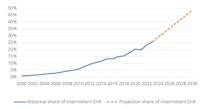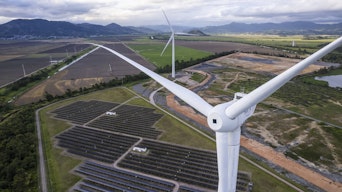Picture the scene. You have raised the cash, jumped through all the permitting hurdles and wrestled with the supply chain and construction challenges to finally commission a merchant renewable energy plant. You sit back to reap the profits—and they do not come.
Instead, the megawatt hours of clean energy that you have so diligently planned for fetch risible prices on wholesale markets, or don’t even get used at all. It is a scenario that is enough to put anyone off investing in renewables—yet one that is starting to play out across Europe and beyond.
The problem is called price cannibalisation, and it is growing along with the buildout of renewables.Regulators recognise the value of clean energy, so megawatt hours from renewable plants get priority on the grid--which is great while the system needs the energy, but what if it does not?
If demand is already being fully met, you cannot tell the sun or the wind to hold on for a while, so you can either disconnect yourplant from the grid, a process known as curtailment, or simply take whatever you can get for your renewable electricity on the spot market, which may not be much.Because renewable energy technologies produce electricity simultaneously—when it is windy in the case of wind or sunny in the case of solar—the chances of price cannibalisation rise along with the amount of low-carbon generation connected to the grid.
You could almost say that the value of wind or solar generation decreases with each megawatt-hour added to the system. And that poses a problem for regions such as the EuropeanUnion (EU), where the share of renewables on the grid is growing fast.

“Over the last five years, the amount of energy provided by renewable sources has increased dramatically (up by 39% since 2017 in Germany) and is expected to satisfy one third of EU requirements in 2026,” said research firm Enerdata in September 2023.
“This change has produced tremendous volatility in energy prices due to the unpredictability of renewable energy output. The cannibalisation effect occurs when too much availability of renewable assets generates higher sales, thus putting pressure on power prices and driving them down.”
To some extent, price cannibalisation can be avoided through grid interconnections. Thus, over-production of power from North Sea wind farms could still find a home if it can be exported to European countries in the East or South.
Similarly, excess solar power from Mediterranean nations could help meet electricity demand in Northern Europe if the energy can be moved efficiently across the continent.
However, interconnection capacity is already in short supply in many parts of Europe, creating ‘energy islands’ such as the British Isles and the Iberian Peninsula where there is an acute risk of price cannibalisation as renewables buildouts continue.
This problem is not restricted to international connections. In the UK, for example, most offshore wind power is generated in the north but the country’s major electricity load centres are in the south, putting a strain on grid connections crossing the nation. Germany faces a similar problem.
Moves are afoot to increase interconnection capacity generally across Europe, with a range of projects underway. By 2030, the interconnection capacity between Spain and France alone is expected to increase by more than 5 GW, according to data provider AleaSoft Energy Forecasting.
But interconnection projects are complex, costly and time consuming, with plenty of margin for delays and cancellations. In the short term, a simpler and easier way to avoid price cannibalisation is to install energy storage.
Safeguarding Demand
Battery system projects such as the 200 MW, 373.5 MWh Sheaf Energy Park that Pacific Green is building in Kent, UK, at the landing point for the massive Thanet offshore wind farm, can store excess renewable energy until the grid needs it—and the price of electricity goes up.

These plants thrive off the variability created by renewable energy generation, because swings in electricity pricing create arbitrage opportunities that improve the return on investment for battery systems. And unlike interconnection projects, battery plants are relatively straightforward to build.
Pacific Green was able to develop the 100 MW Richborough Energy Park in less than two years, for example. The plants can take advantage of brownfield sites or share space with wind or solar plants, simplifying their permitting processes.
And they occupy relatively small areas with no pollution and minimal visual impact, minimising the chances of pushback from local communities.
These benefits are driving massive buildouts of energy storage not only in Europe but also in places such as Australia, which similarly has an increasing share of renewables on the grid and only limited interconnection capacity across the country.
Indeed, the battery projects that Pacific Green is looking to develop in Australia dwarf those in the UK, with Limestone Coast Energy Park weighing in at 500 MW and 1.5 GWh and Portland Energy Park boasting a massive 1 GW and 2.5 GWh of capacity.
Such projects are good news for clean energy investors, for two reasons. The first is that they represent great investment opportunities, giving backers guaranteed returns over a period of decades.
At present, energy storage project returns tend to rely heavily on the provision of grid services such as frequency regulation and voltage control.
But markets for these are limited, and AleaSoft predicts that pricing arbitrage will become the main source of income, along with capacity market payments, for future energy storage projects in places such as Spain.
“In the long term, most of the revenues will come from price arbitrage and capacity payments, leaving remuneration for participation in ancillary services in a residual place,” said AleaSoft.
The second benefit of battery plants is that the ready availability of energy storage on the grid largely does away with the threat of renewables price cannibalization.
Hence, each battery project helps to safeguard demand for further solar and wind projects, adding momentum to the global energy transition and delivering wider benefits that range from more sustainable and secure power supplies to lower air pollution and improved healthcare.
Publish date: 11 March, 2024